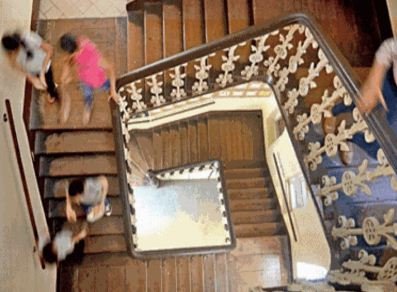Schools get architects to save a chapter of their own history
 When the Bharda High School building was established in the 19th century, its neo-classical facade looked out on the vast expanse of the Bombay esplanade. Sea breeze streamed through the louvered windows of its grand hall, up the majestic central staircase and through the wrought iron grilles crowning its wooden doorways. “You could see all the way to Jer Mahal from here,” says conservation architect Vikas Dilawari, referring to the heritage building that houses Kyani and Company at Metro junction.
When the Bharda High School building was established in the 19th century, its neo-classical facade looked out on the vast expanse of the Bombay esplanade. Sea breeze streamed through the louvered windows of its grand hall, up the majestic central staircase and through the wrought iron grilles crowning its wooden doorways. “You could see all the way to Jer Mahal from here,” says conservation architect Vikas Dilawari, referring to the heritage building that houses Kyani and Company at Metro junction.
The landscape around Bharda has changed in a myriad ways since then— the esplanade has been diced into maidans and the sea has been beaten back by reclamations and tetrapods— but within the school’s walls, an army of painters, masons and carpenters are trying to turn back the clock. Wooden doors are being scraped of paint, marble floors are being polished and its “Bhau-Daji-Lad-Museum-style” staircase —sporting Hindu deities—is being painstakingly restored. “Instead of the usual ‘spit and polish’ repairs, we decided to hire a conservation architect and do a perfect job,” explains trustee Muncherji Cama, adding that a well and stables were discovered during the restoration process because it was once the home of a Bhatia trader.
Like Bharda, a number of Mumbai’s schools are celebrating their history and taking pride in their built heritage. The Byramjee Jejeebhoy Parsi Charitable Institution (BJPCI), a Muscular Gothic structure on Charni Road, has kept Dilawari on its rolls as a maintenance architect for 26 years, while Cathedral and John Connon School’s three colonial-style buildings in Fort— designed by the Royal Bombay Yacht Club’s John Adams—were restored by urban conservationist Brinda Somaya in the 1990s.
At JB Petit High School in Fort, the school’s 156-year-old history is mapped on a colourful bulletin board in a child’s imagination. There’s a smiling Miss Prescott with button eyes and a blue-and-white pinafore, who got the land to start the school for Indian girls in 1867, and a moustachioed Premchand Roychand—sporting an orange turban—who gave the school a generous grant in 1875. And nostalgic selfies with the marble bust of the school’s namesake, philanthropist Jehangir Bomanji Petit, who prevented its takeover by another educational institute, are mandatory for outgoing batches.
JB’s original two-storey stone building—now woefully inadequate for the school’s expanding needs—still exists with its Gothic pillars, arches, cantilevered wooden staircase and eagle perched atop the pediment. Today, the trustees and parent body want to “modernise the campus” by demolishing the later concrete additions and building a contemporary structure. But the school is so attached to its heritage block that they’ve hired conservation architect, Abha Narain Lambah, to ensure that the new structure doesn’t clash with the old. “The heritage committee recently issued a no objection certificate saying, ‘The new structure is a contemporary addition but is respectful and sensitive to the historic building’,” says Lambah.
At BJPCI, Dilawari’s interventions have been sporadic depending on when funds are available. He’s scrubbed the stone arches and pillars free of paint, repaired the school’s piece de resistance, which is a cantilevered stone-cum-wood staircase and restored the stained glass gracing the library’s rose window. Perhaps his most ambitious project was re-creating Athena, the Greek virgin goddess of reason, arts and literature, atop the central pediment. “Only one trustee, who was a former student, remembered the statue, which disappeared many decades ago, and so the new design was based on his recollection,” says principal Pavana Anchees.
Few Mumbai buildings have crowning features—CST boasts a statue of Progress and the BMC building has the Primus in indis–making the BJPCI part of an elite club.
Restoring a school presents unique challenges because classes can’t be stopped indefinitely. Architects must work during the summer holidays and steer clear of construction work during exam season. Raising funds for sensitive restorations also poses a challenge. While the restoration work in Bharda and BJPCI is being funded by the schools’ trusts, JB has set up a fundraising committee. In fact, the principal, Benaifer P Kutar, was told that since JB is a girls’ school—and women don’t control the purse strings in a household—financing the project would be problematic. But JB, which was one of the first schools in the city to admit Indian girls, has a history of defying the odds. “Our girls will meet the challenge,” the principal retorts.
Published on Times Of India





